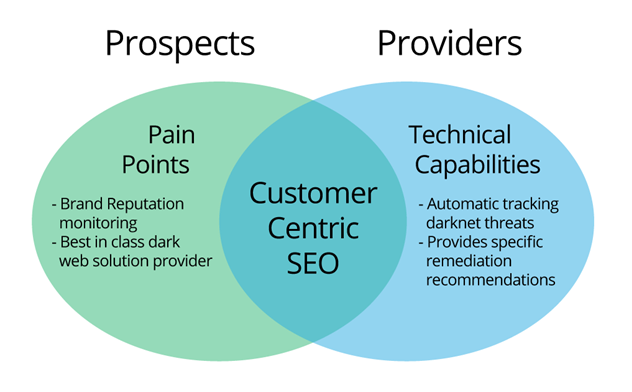One of the most important success factors in improving your SEO is speaking to your customer’s pain points on their terms, not yours. This is the key difference between marketing yourself from a product-centric perspective (we do this, we do that) versus marketing yourself from a customer-centric perspective (I have this problem, I have that problem.)
For example, at W2 Communications we have had the opportunity over the years to work with some of the most brilliant and innovative minds in cybersecurity. However, nine times out of 10 when conducting our initial discovery and content audits, we find that most of their existing messaging focuses on what their product does, and not why it matters or how it actually solves a customer’s problem. Invariably one of the tasks set before us as an integrated communications agency is, “help us improve our messaging and our SEO so our website will generate some leads.” In order to do that, we have to:
- Unearth the real-world business problems their customers have
- Analyze the long-tail keyword bundles that accurately (and relevantly) describe our clients’ solutions
- Expertly craft nuanced messaging combining both
- Deploy that messaging across SEO, SEM, social media, content marketing and PR campaigns

Here’s how this works.
One of our cybersecurity clients is a true expert in Dark Web monitoring, spending untold hours scouring the scariest nether regions of the internet. They know what incredibly advanced techniques they use to find the bad people, but their prospective clients do not. Their clients simply know that they need online brand protection. An example from their main solution page states:
“Well beyond vendors providing broad, generalized information, our industry-leading technologies automatically penetrate the hardest-to-reach corners of the cybercrime underground to provide unique, contextualized intelligence actionable at the tactical, operational and strategic levels – so you can quickly counter targeted threats before they cause harm.”
Do you see the words “online brand protection” in there anywhere? How about “online reputation management” do you see those? Maybe you can find “best dark web provider” in that description? Nope, those aren’t in there either. In fact, that entire passage is a classic SEO failure. Think of it this way, if a prospect doesn’t know that your solution solves their problem, they won’t know to search for it. Here’s how that same passage might be re-written using a customer-centric approach, or in other words, “less about us more about you.”
“Our online brand protection and reputation management solutions are built upon industry-leading dark web monitoring technologies, which automatically penetrate the hardest-to-reach corners of the cybercrime underground. As a best-in-class dark web solution provider, we deliver unique, contextualized intelligence actionable at the tactical, operational and strategic levels – so you can quickly counter targeted threats before they cause harm.”
See how we led with the pain points? That way the reader doesn’t have to wade through a bunch of technical jargon before they get to the part where they realize, “these people may be able to solve my problems.” In fact, you can almost visualize a structure to this methodology as follows:
“Our [pain point #1] and [pain point #2] solutions are built upon [cool technology #1] which solve [scary situation #1]. These provide [value proposition #1] and [value proposition #2] so you can do more [fun things #1] and [fun things #2].”
In addition to putting your customer-centric keywords within the body of the text, you’ll also want to include them in your page title (H1 tag) and subheadings (H2, H3, etc.) as well for better SEO value. Now, not only have you improved your SEO, but you’ve also taken the first step in educating a prospect about your value proposition.
While this example may be an oversimplification of the nuance required to write effective customer-centric messaging, it does illustrate the key issue that many B2B companies face, namely how to “marry up” the problems that your clients face and the innovative solutions that you’ve created.
Our team has the expertise to help you hone your messaging to speak to your customer’s pain points, while also articulating the value your solutions offer. If you would like to learn more, please contact us.




